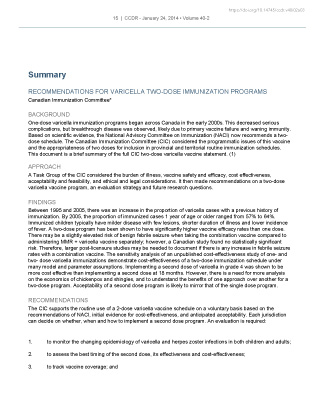Varicella immunization

 Download this article as a PDF (214 KB - 2 pages)
Download this article as a PDF (214 KB - 2 pages) Published by: The Public Health Agency of Canada
Issue: Volume 40-2
Date published: January 24, 2014
ISSN: 1481-8531
Submit a manuscript
About CCDR
Browse
Volume 40-2, January 24, 2014
Summary
Recommendations for varicella two-dose immunization programs
Canadian Immunization Committee*
Affiliation
*The Canadian Immunization Committee (CIC) provides operational and technical advice related to immunization policies and programs in Canada. CIC consists of representatives from provincial and territorial jurisdictions, the National Advisory Committee on Immunization (NACI), the American Advisory Committee on Immunization Practices (ACIP) and Health Canada's Biologics and Genetics Therapies Directorate (BGTD), Marketed Health Products Directorate (MHPD), and First Nations and Inuit Health Branch.
DOI
https://doi.org/10.14745/ccdr.v40i02a03
Background
One-dose varicella immunization programs began across Canada in the early 2000s. This decreased serious complications, but breakthrough disease was observed, likely due to primary vaccine failure and waning immunity. Based on scientific evidence, the National Advisory Committee on Immunization (NACI) now recommends a two-dose schedule. The Canadian Immunization Committee (CIC) considered the programmatic issues of this vaccine and the appropriateness of two doses for inclusion in provincial and territorial routine immunization schedules. This document is a brief summary of the full CIC two-dose varicella vaccine statement.Footnote 1
Approach
A Task Group of the CIC considered the burden of illness, vaccine safety and efficacy, cost effectiveness, acceptability and feasibility, and ethical and legal considerations. It then made recommendations on a two-dose varicella vaccine program, an evaluation strategy and future research questions.
Findings
Between 1995 and 2005, there was an increase in the proportion of varicella cases with a previous history of immunization. By 2005, the proportion of immunized cases 1 year of age or older ranged from 57% to 64%. Immunized children typically have milder disease with few lesions, shorter duration of illness and lower incidence of fever. A two-dose program has been shown to have significantly higher vaccine efficacy rates than one dose. There may be a slightly elevated risk of benign febrile seizure when taking the combination vaccine compared to administering MMR + varicella vaccine separately; however, a Canadian study found no statistically significant risk. Therefore, larger post-licensure studies may be needed to document if there is any increase in febrile seizure rates with a combination vaccine. The sensitivity analysis of an unpublished cost-effectiveness study of one- and two- dose varicella immunizations demonstrate cost-effectiveness of a two-dose immunization schedule under many model and parameter assumptions. Implementing a second dose of varicella in grade 4 was shown to be more cost effective than implementing a second dose at 18 months. However, there is a need for more analysis on the economics of chickenpox and shingles, and to understand the benefits of one approach over another for a two-dose program. Acceptability of a second dose program is likely to mirror that of the single dose program.
Recommendations
The CIC supports the routine use of a 2-dose varicella vaccine schedule on a voluntary basis based on the recommendations of NACI, initial evidence for cost-effectiveness, and anticipated acceptability. Each jurisdiction can decide on whether, when and how to implement a second dose program. An evaluation is required:
- to monitor the changing epidemiology of varicella and herpes zoster infections in both children and adults;
- to assess the best timing of the second dose, its effectiveness and cost-effectiveness;
- to track vaccine coverage; and
- to monitor vaccine safety especially with respect to febrile seizures.
Research is needed to assess the length of protection, the effectiveness of catch-up programs, and the interchangeability of different varicella vaccines.
Page details
- Date modified: